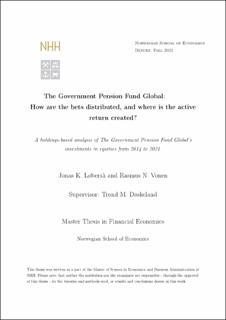The Government Pension Fund Global: How are the bets distributed, and where is the active return created?: A holdings-based analysis of The Government Pension Fund Global’s investments in equities from 2014 to 2021.
Master thesis
Permanent lenke
https://hdl.handle.net/11250/2982100Utgivelsesdato
2021Metadata
Vis full innførselSamlinger
- Master Thesis [4372]
Sammendrag
The Management of the Government Pension Fund Global (hereafter the “Fund”)
is a heated topic. The Fund is managed actively to outperform the benchmark and
generate a positive active return. The literature is skeptical of this possibility, but
the Fund advocates that the active management has yielded a positive active return.
This thesis studies the active management of the equities portfolio of the Fund.
Therefore, a holdings-based analysis is conducted for the time period from 2014 to
2021.
First, we investigate how actively the Fund has been managed. The Fund’s active
management has been low, and we find indications of a decreasing degree of active
management during the time period. Second, we identify how the Fund’s bets can
be divided into overweights and underweights, regions, and industries. We find that
the Fund’s overweights have a larger variation in size than the underweights. Addi tionally, the distribution of bets between regions and industries is largely determined
by their market capitalization. This distribution is somewhat affected by different
degrees of active management in the regions and industries. Third, we investigate
the contribution to the active return from the different groups of overweights and
underweights, regions, and industries. We did not find statistically significant con tributions to the active return from any regions. This was the case for industries
as well, without the exception of a significantly positive contribution to the active
return in Utilities. This positive return was mainly caused by good performance in
security selection. We found a significantly positive contribution from the 20 largest
underweights. We also found indications of a positive contribution to the active re turn from all underweights and a negative contribution from all overweights. These
results were not statistically significant, and we cannot conclude this was caused by
poor or well performance and not a coincidence.
